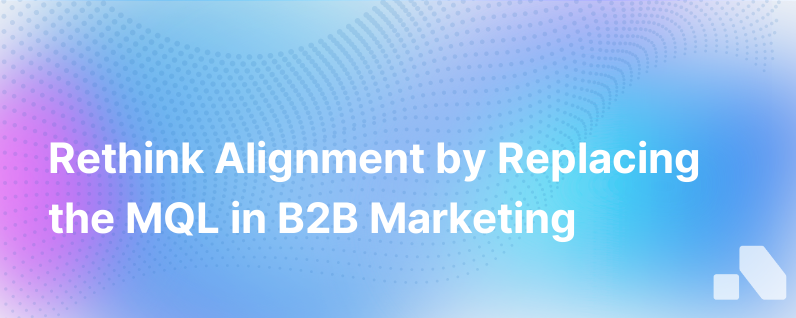Fixing B2B Marketing And Sales Alignment Starts With Replacing The Mql
Published on December 22, 2023 by David Zhang
In the ever-evolving landscape of B2B marketing and sales, alignment between teams is paramount for success. The gap between marketing and sales departments is a tale as old as time, but progressive organizations have begun to unravel this divide, often starting by rethinking the Marketing Qualified Lead (MQL). The MQL as a metric has long been foundational to marketing and sales strategies, but as we pivot into a more cohesive and data-driven era, it may be limiting businesses rather than empowering them.
The need for a common language between marketing and sales is more critical than ever, and the MQL has fallen short. Let’s explore why replacing the MQL is the first step to fixing B2B marketing and sales alignment and what alternatives can foster a harmonious, efficient, and results-driven culture.
The Pitfalls of the MQL Framework
The core of the issue lies within the MQL itself — a lead scoring system based predominantly on engagement metrics. Marketing teams have leveraged MQLs to hand off leads to sales teams, focusing on quantity over quality. However, engagement does not solely indicate sales readiness, and herein lies the crux of the misalignment.
Firstly, the MQL model tends to create a quantity-over-quality conundrum. It often incentivizes marketing teams to generate a high volume of leads, regardless of their actual likelihood to convert into customers. This can lead to sales teams wading through a sea of unqualified prospects, wasting time that could be spent courting viable opportunities.
Secondly, an overreliance on activity-based metrics can paint a misleading picture. It is entirely possible for a lead to exhibit high engagement with marketing materials yet have no purchasing authority or budget. Sales teams handed high-scoring MQLs under these premises can attest to the frustration and inefficiency of chasing leads nowhere near ready for a sales conversation.
A New Approach: Moving Beyond MQLs
Repairing the marketing and sales misalignment starts by redefining what qualifies a lead. This is where Account-Based Marketing (ABM) strategies step into the spotlight, shifting focus from individual leads to collective accounts. ABM champions alignment by engaging marketing and sales in a unified approach targeting the accounts most likely to convert and generate revenue.
In lieu of MQLs, many organizations are now beginning to favor deeper, quality-centric metrics such as:
- Sales Qualified Accounts (SQAs): These focus on company-level engagement and intent, merging multiple lead behaviors within an organization to signal buying readiness.
- Intent Data Metrics: Using third-party intent data to gauge where an account is on their purchasing journey can significantly vet the leads before they reach sales.
- Engagement Scores: Like MQLs, but more nuanced, this approach tallies meaningful interactions collectively at the account level, taking a broader view of an account’s interest.
- Pipeline Contribution: By directly connecting marketing’s efforts to the sales pipeline and revenue, this metric ensures that marketing and sales are truly working towards the common goal of closing deals.
Principles for Repairing Marketing and Sales Misalignment
The transition to a more unified B2B sales and marketing framework involves several foundational changes:
Shared Goals and Objectives
Both marketing and sales should have shared KPIs that revolve around revenue. Objectives like closed-won deals, average deal size, and actual revenue generated offer a communal direction that ties directly to the business's bottom line.
Closed-loop Feedback System
This necessitates a robust communication loop where sales provide feedback on lead quality and marketing refines their targeting and qualifying criteria accordingly. Regular meetings and dashboards shared between both departments can facilitate this exchange of insights and feedback.
Integrated Technology Stacks
Marketing technologies (MarTech) and sales enablement tools should be seamlessly integrated. This integrated tech stack allows both teams to share insights, automate parts of the alignment process, and maintain clean, consistent data.
Customer-centric, Account-focused Outcomes
The customer's buying journey should be the guiding star for both teams. Focusing on account engagement and customer lifecycle stage, rather than the activities of individual leads, creates a unified view that both sales and marketers can act upon.
Strategic Content
Marketing should work in lockstep with sales to understand the type of content that moves the needle in sales conversations and then prioritize the creation of such assets. This type of content fosters meaningful conversation and nurtures key accounts towards sales-readiness.
The Solution: Orchestrating Marketing and Sales Symbiosis
The solution to alignment not only lies in abandoning the MQL but also in embracing cross-department collaboration centered on shared data, objectives, and customer success. Tools like Aomni help smoothen this transition. Platforms that allow real-time account research, delivering tailored insights, and updating sales content ensure that both sales and marketing work from the same playbook and aim for the same outcomes.
By adopting these strategies and utilizing modern tools, marketing, and sales teams can focus on driving meaningful revenue together. The result is a cohesive, customer-centric approach where the success of both teams is for the greater good of the company's growth and longevity.
In conclusion, fixing B2B marketing and sales alignment starts with reevaluating the metrics that dictate business processes. It requires overhauling traditional role definitions and performance indicators like the MQL. When both teams operate with a synchronized strategy aiming for the same end goal — customer acquisition and growth — the entire organization stands to reap the benefits.